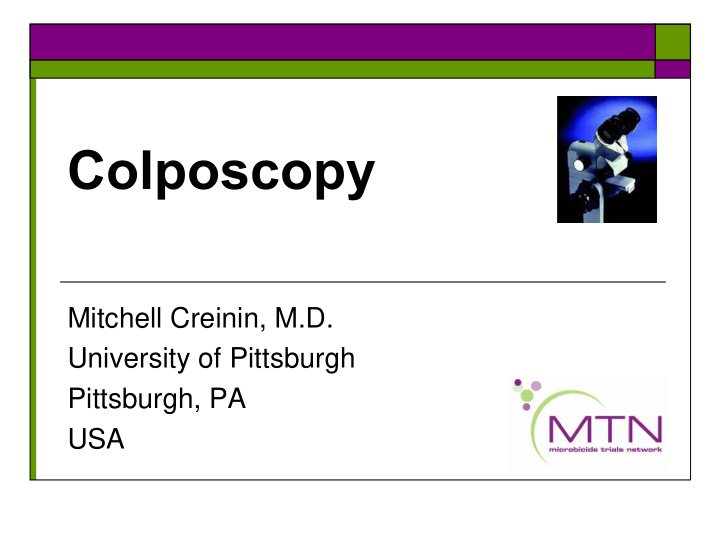



Colposcopy Mitchell Creinin, M.D. University of Pittsburgh Pittsburgh, PA USA
Evaluating Safety How do we evaluate the safety of candidate microbicides? � Systemic safety � AE’s, lab values, exam, etc. � Local safety � AE’s, flora changes, exam, etc. � Colposcopy
Colposcopy � Standard for safety assessment of vaginal products � Goal = detection of epithelial changes that may increase the likelihood of acquisition of HIV or other STI � Generally accepted reference is the WHO/CONRAD Manual
History � 1995 WHO meeting � "Manual for the Standardization of Colposcopy for � the Evaluation of Vaginally Administered Products” � 1999 Revised in conjunction with expert review � convened by CONRAD and WHO “Update 2000” � � 2003 Third conference of experts � “Update 2004” �
Epithelial Changes � Hypothesis: Epithelial changes increase risk of infection � Epithelial Changes � breaks in the epithelium � inflammation � other not well-characterized changes � Multiple Causes
What Do Epithelial Changes Mean? Epithelial changes could … � lead to an increased risk of STI, including HIV, or � cause discomfort without increasing the risk of infection, or � be of no clinical significance!!!
Minor vs. Significant Lesions SIGNIFICANT MINOR � full thickness � peeling epithelial � ecchymosis disruption � petechiae � abrasion � erythema � laceration � acetowhite lesion � ulceration � non-acetowhite � subepithelial lesion hemorrhage with edema
Normal Cervix Mucosa � Typically uniformly pink � Epithelium intact � Vessels intact
Erythema Reddened areas � Margins may or may not be clearly defined � Epithelium intact � Vessels intact
Edema � Epithelium � Intact � Swollen � Vessels � Intact � Color: normal or pale
Petechiae Gland � Individual or group Os � Epithelium intact � Vessels disrupted � ≤ 3mm
Ecchymosis � Epithelium intact � Vessels disrupted � >3mm � Color is red or purple
Peeling of Vagina Cervix
Cervical Os Peeling of Cervix
Abrasion � Epithelium disrupted (superficial or deep) � Vessels disrupted � Diffuse or poorly demarcate d outline
Laceration Epithelium disrupted � (superficial or deep) Vessels intact or � disrupted Sharply demarcated � linear finding Fissures appear to � be linear “pulling apart” or wearing away of tissue Lacerations appear � to be from trauma
Limitations of Colposcopy � Requires: reliable electricity, expensive equipment, specific training � Variation between observers � Large number of observations but…which ones are important when evaluating safety
Training � Different evaluation than for dysplasia � Manipulation � Angles � Recording � 3-6 months of proctoring
Variations between observers � 14 subjects, 2 observers � 5 paired examinations � No product use � Colposcopic examination averaged 7 min. � More findings with magnification than naked eye (both major and minor lesions). � Moderate agreement between examiners. Ballagh SA, et al. Contraception 2004;70:241-9.
Baseline lesions: types * p=0.02 O’Neill E, et al. Contraception 2008 (in press).
Baseline lesions: location O’Neill E, et al. Contraception 2008 (in press).
Summary � Colposcopy is an unvalidated standard � Colposcopy finds more lesions � Some naked eye lesions shown to be normal with colposcopy � Many lesions are present without product use � High cost colposcopy not proven with product use
Funding MTN is funded by NIAID (5U01AI068633), NICHD and NIMH, all of the U.S. National Institutes of Health
Recommend
More recommend